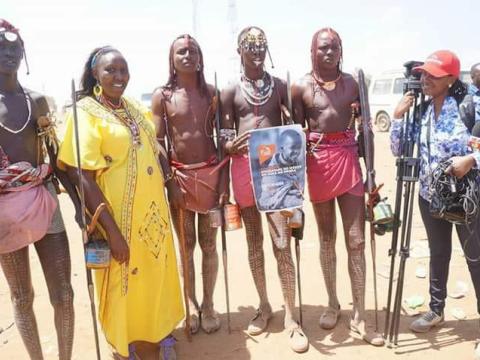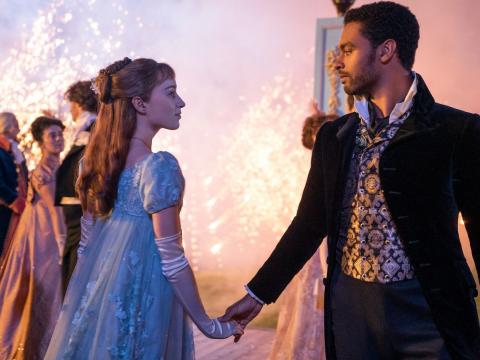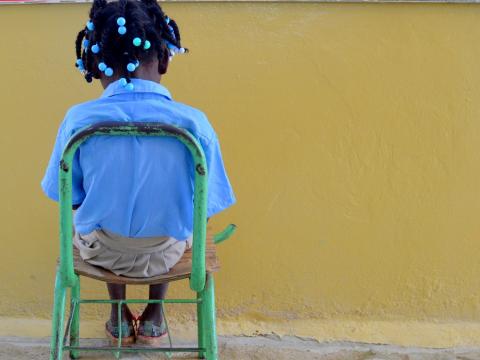
I came back home to stop child marriage
Phiona shares how she went from growing up in a community with almost universal child marriage to combating it.
By Phiona Koyiet, Senior Technical Advisor, Mental Health and Psychosocial, World Vision
In my Maasai tribe, if you are born a girl, child marriage is a cultural practice that is your destiny. The tribe is pastoralist – raising cows and goats. Typically, Maasai girls are circumcised between 11-13 and then soon married off to a man chosen by her father in exchange for cattle. The consequences of FGM and early marriage on girls are grave, not least the fact that girls who marry early are often forced to leave school and terminate their education.
The recent World Vision report COVID-19 and Child Marriage makes data-based connections between child marriage and hunger, parental support, and access to education. Growing up, I saw first-hand the ways in which these, combined with harmful traditional practices, were driving child marriage rates among the Maasai.
Multiple barriers to education
Safe access
Beyond such limiting parental attitudes, just getting to school was a challenge. The shortest route to school was through the forest, but it was too dangerous, especially if you’re a girl. So, you’d have to walk long distances around. The risk of being attacked helped contribute to the rationale that that girls should stop education and be married off early.
Food
There wasn’t much food in the village and it was often hard to focus in classes with a grumbling stomach. Schools were very far away from home, so once you were there, there was no way you could go back for lunch.
Movement
Because the community is pastoralist, at certain points in the year everyone packs up and takes the animals elsewhere to graze. Schools don’t operate during that time; it’s something that hasn’t changed much since I grew up. Some charities have tried to set up mobile schooling that follows the herds, but even though it’s just the boys going with the livestock, girls are still missing school.
Dust and water
If you were one of the 35% of Maasai children going to school back in the ’90s, you’d often find a dusty sand floor in the classroom that meant you needed to bring several litres of water with you to school. The water was to sprinkle on the floor to keep it from being too dusty. It was another obstacle for children to overcome. They’d have to go to the river for water to wash and cook, and then go for more water to take to school. The county governments are starting to improve things now, but there’s still only concrete floors in some schools.
Attitudes
I was lucky that my father had been exposed to the importance of education. My mothers (my father was polygamous) were Christian, and between his exposure to religion and his job in town, he was convinced that my siblings and I should be educated.
Just one generation ago, less than 20 percent of Maasai women in Kenya enrolled in school. Today, even with free primary school education in Kenya since January 2003, only 48 percent of Maasai girls enroll in school, and only 10 percent of girls make it to secondary school.
Because of the environment in our community, my dad sent me away to school so I’d be safe and not teased for studying. I came back at age 13 to sit my final primary school exam, and when I did there was only one other girl left in school to take the exam. A couple weeks later, she too was married.
Stopping child marriage and encouraging education through child sponsorship
Years later, I returned as an area programme manager for a World Vision child sponsorship project in the area. I was determined to make a difference in the lives of the girls. My main motivation for working in the charity sector was to rescue girls from marriage and tell families about the importance of education for their children.
It was amazing to see the difference sponsorship made in the community – it was like knowing sponsors wanted to see children in school somehow validated the value of an education for the Maasai. Every year, when we brought child sponsorship to a new community, we’d see a surge in school enrolment the year after. Child sponsorship influenced parents’ understanding of the importance of an education, and visits to the community by sponsors were even more important. In a community that didn’t traditionally value education or girls, it showed that children were special, valued, and supported.
Still, it takes a long time to change harmful traditional practices, and that’s why World Vision’s long-term commitment to a community through child sponsorship is so important. There were some really heart-breaking situations: girls would walk day and night to World Vision when they heard there was a plan for their marriage.
We had one nine-year-old who girl who spent three nights in the forest. A lion had seen her climb up a tree to sleep, and he stayed below her, waiting for days for her to come down, before he finally gave up. When she arrived at the office, she was so dehydrated she couldn’t speak, and it took her one week to tell her story. Thankfully I was a trained psychologist by this time too and could help.
We reached out to her family right away, but this girl stayed with us for almost a month before she felt safe again. The families aren’t supporting child marriage out of any ill will to their daughters, but because it’s their tradition. They don’t see much value in education, and they worry a girl who isn’t married early will be poorer later in life.
It helped for the community to see me, a woman from their culture, working and educated. I could speak their language, and show them that another future was possible for their girls.
Eventually, we found another school for this little girl, one where the teachers were well trained and where we were confident that neither the teachers nor children would bully her for not being married. She transformed that community through her actions and determination to escape child marriage, and her story became an example to others.
There’s now a Child Rescue Centre in the community, funded by the US Women of Faith Ministry, so no one else has to sleep in the forest to escape child marriage. However, until we remove barriers to education, increase parental support, and remove other factors contributing to child marriage, the rescue centre will continue to be necessary.
To learn more about World Vision's Child Protection programming click here
Why not sponsor a child today!

